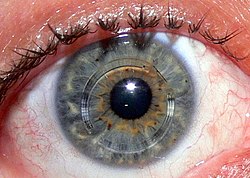Intrastromal corneal ring segment
| Intrastromal corneal ring segment | |
|---|---|
 A pair of corneal rings after insertion into the cornea | |
| Other names | Intrastromal corneal ring |
| Specialty | Ophthalmology |
An intrastromal corneal ring segment (ICRS) (also known as intrastromal corneal ring, corneal implant or corneal insert) is a small device surgically implanted in the cornea of the eye to correct vision. Two crescent or semi-circular shaped ring segments are inserted between the layers of the corneal stroma, one on each side of the pupil,[1] This is intended to flatten the cornea and change the refraction of light passing through the cornea on its way into the eye.
A newer approach to ICRS is Corneal Allogenic Ring Segments (CAIRS[2]) which is a type of keratoplasty or corneal transplant. In this procedure human allogenic corneal tissue is implanted in the same way that ICRS are implanted. CAIRS keratoplasty has the advantage of few complications and typically better outcomes than traditional ICRS.
Design
[edit]Intrastromal corneal ring segments have many different types and designs. Manufacturers include Intacs (US), Cornealring (Brazil), Mediphacos Keraring (Brazil),[3] Ferrara ring (Brazil),[4] Myoring (Austria)[5] and Intraseg (UK).
Medical uses
[edit]Intrastromal corneal rings were originally used to treat mild myopia.[1] For this purpose, they have largely been superseded by excimer lasers, which have better accuracy.[1] They are now mostly used to treat mild to moderate keratoconus.[1] Intrastromal corneal rings were approved in 2004 by the Food and Drug Administration for people with keratoconus who cannot adequately correct their vision with glasses or contact lenses, and for whom corneal transplant is the only other option.[6] They were approved under the Humanitarian Device Exemption,[4][7] which means the manufacturer did not have to demonstrate effectiveness. According to the FDA, these products should not be used by people who "can achieve functional vision on a daily basis using contact lenses."[6]
References
[edit]- ^ a b c d Rabinowitz YS (2013). "INTACS for keratoconus and ectasia after LASIK". Int Ophthalmol Clin. 53 (1): 27–39. doi:10.1097/IIO.0b013e3182774453. PMC 3653443. PMID 23221883.
- ^ Jacob, Soosan; Patel, Shaila R.; Agarwal, Amar; Ramalingam, Arvind; Saijimol, A.I.; Raj, John Michael (May 2018). "Corneal Allogenic Intrastromal Ring Segments (CAIRS) Combined With Corneal Cross-linking for Keratoconus". Journal of Refractive Surgery. 34 (5): 296–303. doi:10.3928/1081597X-20180223-01. ISSN 1081-597X.
- ^ "Keraring - Anel intraestromal". Mediphacos (in Brazilian Portuguese). Retrieved 2024-08-14.
- ^ a b Zadnik K, Lindsley K (2014). "Intrastromal corneal ring segments for treating keratoconus (Protocol)". Cochrane Database of Systematic Reviews. doi:10.1002/14651858.CD011150. PMC 6516208.
- ^ "ICRS: Corneal Biomechanics Effects - EyeWiki". eyewiki.aao.org.
- ^ a b Food and Drug Administration (26 July 2004). "INTACS Prescription Inserts for Keratoconus - H040002". Food and Drug Administration. Archived from the original on July 9, 2009.
- ^ Food and Drug Administration (9 June 2006). "Humanitarian Device Exemption (HDE)".
